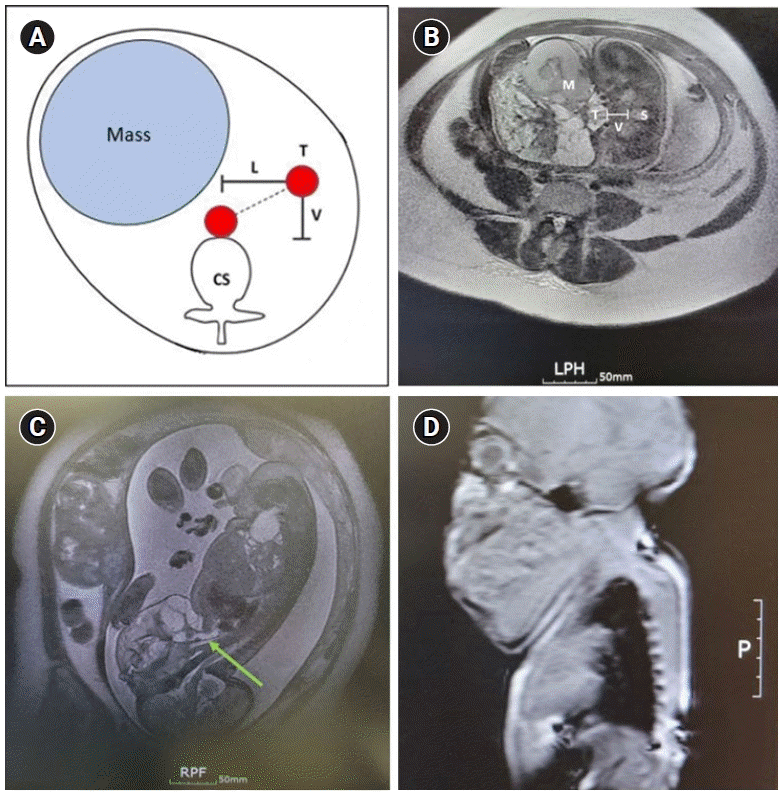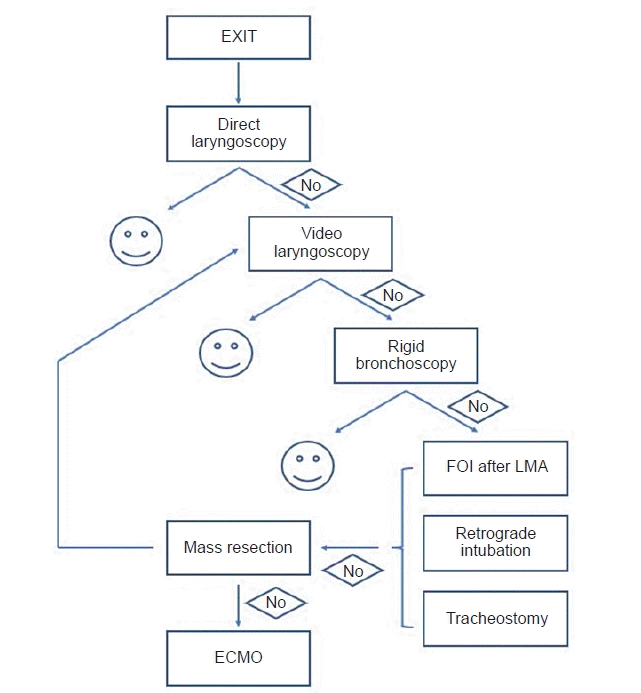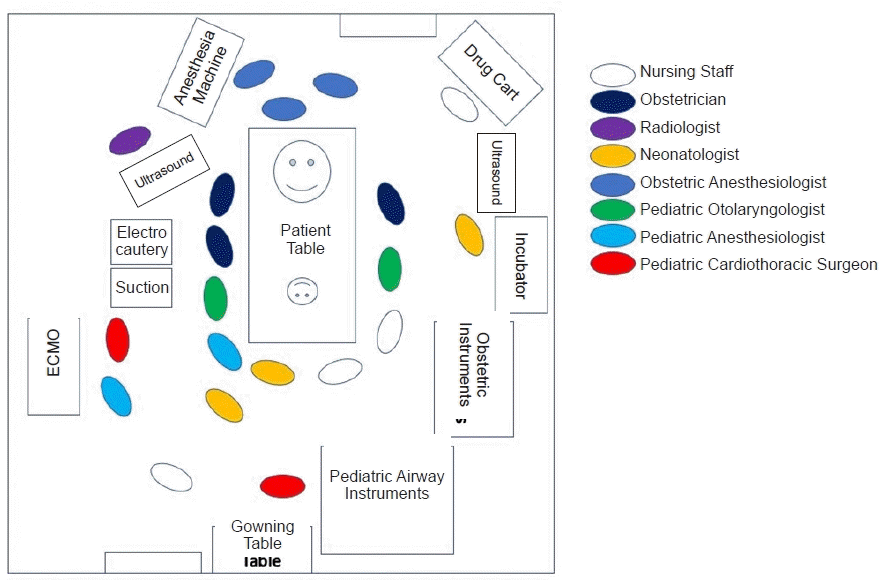1. Harrison MR, Golbus MS, Filly RA, Callen PW, Katz M, de Lorimier AA, et al. Fetal surgery for congenital hydronephrosis. N Engl J Med. 1982; 306:591–3.
2. Norris MC, Joseph J, Leighton BL. Anesthesia for perinatal surgery. Am J Perinatol. 1989; 6:39–40.
3. Mychaliska GB, Bealer JF, Graf JL, Rosen MA, Adzick NS, Harrison MR. Operating on placental support: the ex utero intrapartum treatment procedure. J Pediatr Surg. 1997; 32:227–30; discussion 230-1.
4. Dighe MK, Peterson SE, Dubinsky TJ, Perkins J, Cheng E. EXIT procedure: technique and indications with prenatal imaging parameters for assessment of airway patency. Radiographics. 2011; 31:511–26.
5. Hirose S, Sydorak RM, Tsao K, Cauldwell CB, Newman KD, Mychaliska GB, et al. Spectrum of intrapartum management strategies for giant fetal cervical teratoma. J Pediatr Surg. 2003; 38:446–50; discussion 446-50.
6. Lazar DA, Cassady CI, Olutoye OO, Moise KJ Jr, Johnson A, Lee TC, et al. Tracheoesophageal displacement index and predictors of airway obstruction for fetuses with neck masses. J Pediatr Surg. 2012; 47:46–50.
7. Crombleholme TM, Coleman B, Hedrick H, Liechty K, Howell L, Flake AW, et al. Cystic adenomatoid malformation volume ratio predicts outcome in prenatally diagnosed cystic adenomatoid malformation of the lung. J Pediatr Surg. 2002; 37:331–8.
8. Bouchard S, Johnson MP, Flake AW, Howell LJ, Myers LB, Adzick NS, et al. The EXIT procedure: experience and outcome in 31 cases. J Pediatr Surg. 2002; 37:418–26.
9. Albanese CT, Lopoo J, Goldstein RB, Filly RA, Feldstein VA, Calen PW, et al. Fetal liver position and perinatal outcome for congenital diaphragmatic hernia. Prenat Diagn. 1998; 18:1138–42.
10. Metkus AP, Filly RA, Stringer MD, Harrison MR, Adzick NS. Sonographic predictors of survival in fetal diaphragmatic hernia. J Pediatr Surg. 1996; 31:148–51; discussion 151-2.
11. Butler CR, Maughan EF, Pandya P, Hewitt R. Ex utero intrapartum treatment (EXIT) for upper airway obstruction. Curr Opin Otolaryngol Head Neck Surg. 2017; 25:119–26.
12. Mohammad S, Olutoye OA. Airway management for neonates requiring ex utero intrapartum treatment (EXIT). Paediatr Anaesth. 2020; 30:248–56.
13. Martinez D. Prenatal ultrasound diagnosis of congenital lung lesions. Pediatr Pulmonol. 2001; Suppl 23:120–1.
14. Liechty KW. Ex-utero intrapartum therapy. Semin Fetal Neonatal Med. 2010; 15:34–9.
15. Kumar K, Miron C, Singh SI. Maternal anesthesia for EXIT procedure: a systematic review of literature. J Anaesthesiol Clin Pharmacol. 2019; 35:19–24.
16. Hofer IS, Mahoney B, Rebarber A, Beilin Y. An ex utero intrapartum treatment procedure in a patient with a family history of malignant hyperthermia. Int J Obstet Anesth. 2013; 22:146–8.
17. Chooi C, Cox JJ, Lumb RS, Middleton P, Chemali M, Emmett RS, et al. Techniques for preventing hypotension during spinal anaesthesia for caesarean section. Cochrane Database Syst Rev. 2020; 7:CD002251.
18. Noah MM, Norton ME, Sandberg P, Esakoff T, Farrell J, Albanese CT. Short-term maternal outcomes that are associated with the EXIT procedure, as compared with cesarean delivery. Am J Obstet Gynecol. 2002; 186:773–7.
19. Chatterjee D, Arendt KW, Moldenhauer JS, Olutoye OA, Parikh JM, Tran KM, et al. Anesthesia for maternal-fetal interventions: a consensus statement from the American Society of Anesthesiologists Committees on Obstetric and Pediatric Anesthesiology and the North American Fetal Therapy Network. Anesth Analg. 2021; 132:1164–73.
20. Fink RJ, Allen TK, Habib AS. Remifentanil for fetal immobilization and analgesia during the ex utero intrapartum treatment procedure under combined spinal-epidural anaesthesia. Br J Anaesth. 2011; 106:851–5.
21. George RB, Melnick AH, Rose EC, Habib AS. Case series: combined spinal epidural anesthesia for cesarean delivery and ex utero intrapartum treatment procedure. Can J Anaesth. 2007; 54:218–22.
22. Chinnappa V, Halpern SH. The ex utero intrapartum treatment (EXIT) procedure: maternal and fetal considerations. Can J Anaesth. 2007; 54:171–5.
23. Ngamprasertwong P, Vinks AA, Boat A. Update in fetal anesthesia for the ex utero intrapartum treatment (EXIT) procedure. Int Anesthesiol Clin. 2012; 50:26–40.
24. Ross MG, Gala R. Use of umbilical artery base excess: algorithm for the timing of hypoxic injury. Am J Obstet Gynecol. 2002; 187:1–9.
25. Laje P, Johnson MP, Howell LJ, Bebbington MW, Hedrick HL, Flake AW, et al. Ex utero intrapartum treatment in the management of giant cervical teratomas. J Pediatr Surg. 2012; 47:1208–16.
26. Byun SH, Lee SY, Hong SY, Ryu T, Kim BJ, Jung JY. Use of the GlideScope video laryngoscope for intubation during ex utero intrapartum treatment in a fetus with a giant cyst of the 4th branchial cleft: a case report. Medicine (Baltimore). 2016; 95:e4931.
27. Jaeel P, Sheth M, Nguyen J. Ultrasonography for endotracheal tube position in infants and children. Eur J Pediatr. 2017; 176:293–300.
28. Pucher B, Szydlowski J, Jonczyk-Potoczna K, Sroczynski J. The EXIT (ex-utero intrapartum treatment) procedure - from the paediatric ENT perspective. Acta Otorhinolaryngol Ital. 2018; 38:480–4.
29. Park HJ, Lee JH, Chung SM, Kim HS. A case of the EXIT (ex utero intrapartum treatment) procedure in congenital fetal cervical immature teratoma. Korean J Otorhinolaryngol-Head Neck Surg. 2008; 51:681–5.
30. Wyckoff MH, Aziz K, Escobedo MB, Kapadia VS, Kattwinkel J, Perlman JM, et al. Part 13: neonatal resuscitation: 2015 American Heart Association guidelines update for cardiopulmonary resuscitation and emergency cardiovascular care (reprint). Pediatrics. 2015; 136 Suppl 2:S196–218.
31. Baker PA, Aftimos S, Anderson BJ. Airway management during an EXIT procedure for a fetus with dysgnathia complex. Paediatr Anaesth. 2004; 14:781–6.
32. Morris LM, Lim FY, Elluru RG, Hopkin RJ, Jaekle RK, Polzin WJ, et al. Severe micrognathia: indications for EXIT-to-Airway. Fetal Diagn Ther. 2009; 26:162–6.
33. Mihara T, Asakura A, Owada G, Yokoi A, Ka K, Goto T. A network meta-analysis of the clinical properties of various types of supraglottic airway device in children. Anaesthesia. 2017; 72:1251–64.
34. Trevisanuto D, Parotto M, Doglioni N, Ori C, Zanardo V, Micaglio M. The Supreme Laryngeal Mask Airway™ (LMA): a new neonatal supraglottic device: comparison with Classic and ProSeal LMA in a manikin. Resuscitation. 2012; 83:97–100.
35. Dhara SS. Retrograde tracheal intubation. Anaesthesia. 2009; 64:1094–104.
36. Sachdev A, Chhawchharia R. Flexible fiberoptic bronchoscopy in pediatric practice. Indian Pediatr. 2019; 56:587–93.
37. Cammack B, Noel-MacDonnell J, Cuna A, Manimtim W. Impact of tracheostomy on language and cognitive development in infants with severe bronchopulmonary dysplasia. J Perinatol. 2020; 40:299–305.
38. Stephenson KA, Wyatt ME. Neonatal tracheostomy. Int J Head Neck Surg. 2016; 7:136–42.
39. Tweedie DJ, Skilbeck CJ, Cochrane LA, Cooke J, Wyatt ME. Choosing a paediatric tracheostomy tube: an update on current practice. J Laryngol Otol. 2008; 122:161–9.
40. Bartlett RH, Andrews AF, Toomasian JM, Haiduc NJ, Gazzaniga AB. Extracorporeal membrane oxygenation for newborn respiratory failure: forty-five cases. Surgery. 1982; 92:425–33.
41. Kunisaki SM, Barnewolt CE, Estroff JA, Myers LB, Fauza DO, Wilkins-Haug LE, et al. Ex utero intrapartum treatment with extracorporeal membrane oxygenation for severe congenital diaphragmatic hernia. J Pediatr Surg. 2007; 42:98–104; discussion 104-6.





 PDF
PDF Citation
Citation Print
Print





 XML Download
XML Download